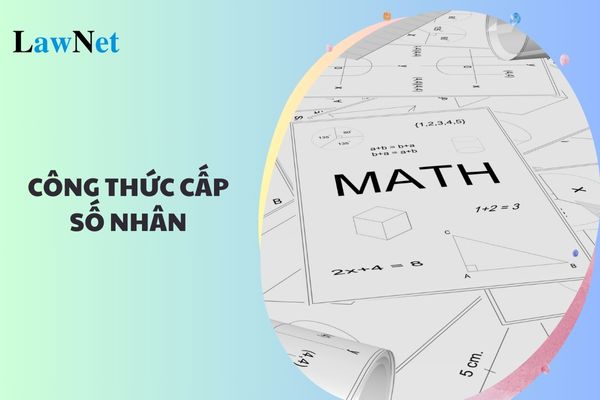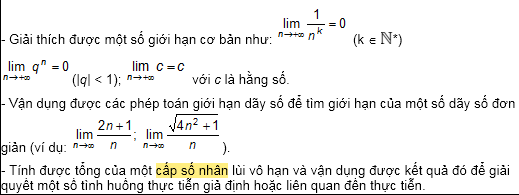What is the formula for a geometric progression? From which grade will students in Vietnam learn geometric progression?
What is the formula for a geometric progression?
A geometric progression (geometric sequence) is a sequence of numbers where, starting from the second term, each term equals the previous term multiplied by a constant number. This constant number is called the common ratio of the geometric progression, usually denoted by q.
Example: The sequence 1, 2, 4, 8, 16,... is a geometric progression with a common ratio q = 2.
|
* Main elements of a geometric progression - First term: The first term in the sequence, usually denoted by u1. General term: un = u1 * q^(n-1) (This formula helps us find any term in the sequence if we know the first term and the common ratio). Sn = u1 * (1 - q^n) / (1 - q) (with q ≠ 1) (This formula is used to calculate the sum of the first n terms of the geometric progression). |
*Note: The information is for reference purposes only./.

What is the formula for geometric progression? When will students learn it? (Image from the Internet)
When will students in Vietnam learn the formula for geometric progression?
According to Section V of the Appendix to the Mathematics Curriculum of the General Education Program issued together with Circular 32/2018/TT-BGDDT, the requirements for writing skills in Vietnamese for Grade 5 are as follows:
Students will learn following lessons on the sequence section, arithmetic progression, geometric progression
[1] Geometric progression, general term of a geometric progression, sum of the first n terms of a geometric progression whereby students are required to:
- Recognize a sequence as a geometric progression.
- Explain the formula to determine the general term of a geometric progression.
- Calculate the sum of the first n terms of a geometric progression.
- Solve practical problems related to geometric progression to solve some real-world problems (e.g., some issues in Biology, Population Education,...).
[2] Limits of sequences. Operations on sequence limits. Sum of an infinite geometric progression, whereby students are required to:

Thus, according to the regulations, students will learn the formula for geometric progression from the grade 11 Mathematics curriculum.
What mathematical competencies are developed by the Mathematics according the 2018 General Education Program in Vietnam?
According to Section III of the Appendix to the Mathematics Curriculum of the General Education Program issued together with Circular 32/2018/TT-BGDDT, Mathematics in the 2018 General Education Program helps develop the following mathematical competencies:
The Mathematics Curriculum helps students achieve the following main objectives:
- Develop mathematical competencies, including core components such as mathematical thinking and reasoning skills, mathematical modeling skills, problem-solving skills, mathematical communication skills, and skills in using tools and means to learn mathematics.
- Contribute to forming and developing essential qualities and common competencies in students according to levels appropriate to the subject, educational level stipulated in the Overall Program.
- Have basic, essential general mathematical knowledge and skills; develop problem-solving capabilities with interdisciplinary integration between Mathematics and other subjects such as Physics, Chemistry, Biology, Geography, Information Technology, Technology, History, Arts,...; create opportunities for students to experience and apply mathematics in practice.
- Have a relatively general understanding of the usefulness of mathematics in various careers to provide a basis for career orientation, as well as sufficient competencies to explore mathematical issues throughout their life.
Thus, the goal of Mathematics in the 2018 General Education Program is to develop the following mathematical competencies:
- Mathematical thinking and reasoning skills;
- Mathematical modeling skills.
Additionally, at different educational levels, specific objectives must be met as follows:
* Objectives at the primary education level
The primary education level aims to help students achieve the following main objectives:
- Contribute to forming and developing mathematical competencies with the requirements to be achieved: perform basic thinking operations at a simple level; pose and answer questions when reasoning and solving simple problems; select mathematical operations and formulas for arithmetic to present, express (orally or in writing) contents, ideas, and ways to solve problems; use mathematical language combined with common language and body movements to express mathematical content in simple situations; use simple tools and means to carry out tasks in mathematics learning.
- Have basic and essential initial mathematical knowledge and skills about:
+ Numbers and calculations: Natural numbers, fractions, decimals, and operations on those sets of numbers.
+ Geometry and Measurement: Observe, identify, describe shapes and features (at a visual level) of some flat shapes and solids in practice; create some simple geometric models; calculate some geometric quantities; develop spatial imagination; solve some practical problems tied to Geometry and Measurement (with common measurement units).
+ Statistics and Probability: Some basic elements of statistics and probability; solve some simple practical problems related to statistics and probability.
- Along with other subjects and educational activities such as Ethics, Nature and Society, Experiential Activities,... contribute to helping students have initial understandings of some careers in society.
* Objectives at the lower secondary education level
The lower secondary education level aims to help students achieve the following main objectives:
- Contribute to forming and developing mathematical competencies with the requirements to be achieved: pose and answer questions when reasoning, solving problems; perform reasonable reasoning when solving problems; prove not too complex mathematical propositions; use mathematical models (mathematical formulas, algebraic equations, representations,...) to describe real-world problems in not too complex scenarios; use mathematical language combined with common language to express mathematical content and demonstrate evidence, reasoning, and results; present ideas and use tools, math learning means to accomplish a learning task or express mathematical reasoning.
- Have basic mathematical knowledge and skills about:
+ Numbers and Algebra: Number system (from natural numbers to real numbers); calculation and use of calculating tools; algebraic language and symbols; transformation of algebraic expressions, equations, systems of equations, inequalities; use of functional language to describe (model) some processes and phenomena in practice.
+ Geometry and Measurement: The content of Geometry and Measurement at this level includes Visual Geometry and Plane Geometry. Visual Geometry continues to provide language, symbols, describes (visually) objects in practice (flat shapes, solids); create some common geometric models; calculate some geometric elements; develop spatial imagination; solve some practical problems tied to Geometry and Measurement. Plane Geometry provides knowledge and skills (at a level of logical reasoning) about geometric relationships and some common flat shapes (point, line, ray, segment, angle, two parallel lines, triangle, quadrilateral, circle).
+ Statistics and Probability: Collect, classify, display, analyze, and process statistical data; analyze statistical data through frequency, relative frequency; identify some simple statistical laws in practice; use statistical analysis to understand basic concepts of experimental probability and event probability; recognize the significance of probability in practice.
+ Contribute to helping students have initial understandings of careers related to Mathematics; foster career awareness based on abilities and interests, conditions, and circumstances of oneself; guide educational streamlining after lower secondary education (continue studying, vocational training, or enter the labor market).
- Upper secondary school level objectives
The upper secondary school level aims to help students achieve the following main objectives:
+ Contribute to forming and developing mathematical competencies with the requirements to be achieved: pose and answer questions when reasoning, solving problems; use reasoning methods, induction, and deduction to understand different approaches to solve problems; establish mathematical models to describe situations, thereby proposing a solution to the mathematical problems posed in the established model; implement and present the problem-solving solutions and evaluate the solutions, generalize for similar problems; use tools and means for studying Mathematics to discover and solve mathematical problems.
+ Have basic and essential mathematical knowledge and skills about:
++ Algebra and Elements of Calculus: Calculation and use of calculating tools; use of algebraic language and symbols; transformation of algebraic and transcendental expressions (trigonometric, exponential, logarithmic), equations, systems of equations, inequalities; recognition of basic elementary functions (power, trigonometric, exponential, logarithmic); study functions and draw graphs using the derivative; use of integral calculus to calculate areas of plane figures and volumes of solids in space.
+ Geometry and Measurement: Provide knowledge and skills (at a level of logical reasoning) about geometric relationships and some familiar planar and solid shapes; algebraic methods (vector, coordinate) in geometry; develop spatial imagination; solve practical problems tied to Geometry and Measurement.
+ Statistics and Probability: Improve the capabilities of collecting, classifying, displaying, analyzing, and processing statistical data; use analysis tools for statistical data through central tendency measures and dispersion measures for grouped and ungrouped data; use statistical laws in practice; recognize random models, basic concepts of probability, and the significance of probability in practice.
+ Contribute to providing students with a relatively general understanding of careers related to Mathematics and its value; provide a basis for career orientation after upper secondary school; have minimal competencies to explore mathematical issues throughout life.

